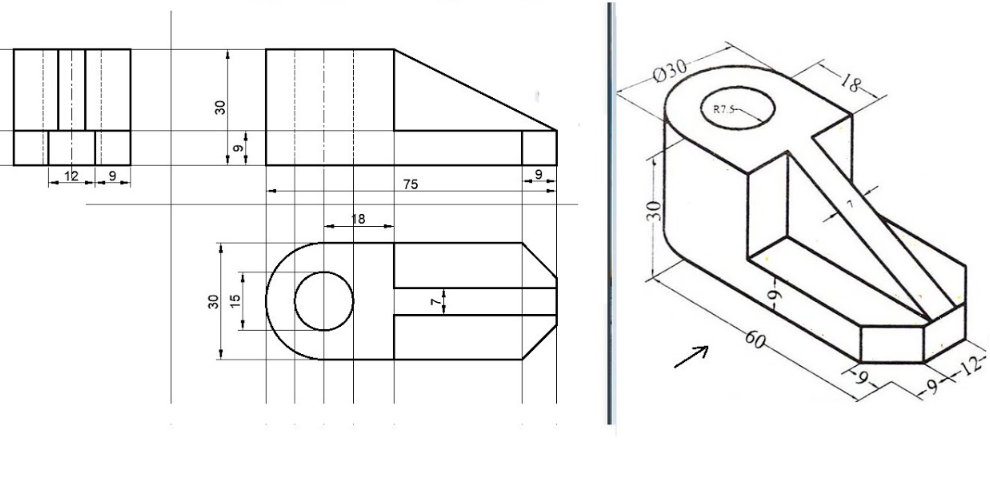The façade is commonly the most well-known element of a technical drawing. It provides one of the most interesting perspective of a things, catching its height and size while obscuring deepness. This view is commonly the very first drawing to be created and acts as the reference factor for developing added views. The primary objective of the front view is to supply a clear, simple depiction of the object that stresses essential functions, dimensions, and percentages. This view stabilizes the drawing procedure, allowing developers to work from this standard perspective, making certain that subsequent views straighten correctly which all featuresline up as intended.
Building upon this, the top sight complements the façade by providing info concerning the depth of the item. This view enables developers to see exactly how vast and deep the object is, getting rid of ambiguity that may emerge from the initial façade alone. The top sight helps to picture relationships in between various elements of the style, making it easier to comprehend the format of components, particularly in detailed systems with numerous overlapping components. When utilized successfully, the leading view can aid communicate necessary aspects of performance and spatial setup that are vital for producing and setting up.
The side sight, also known as the profile view, uses yet an additional viewpoint by illustrating the things's elevation and deepness. By including the side sight right into the technical drawing, developers ensure that all measurements can be properly presented, creating a comprehensive view of the object.
Explore technical drawing views the important function of technical drawing in engineering and design, highlighting essential views such as front, top, side, section, and isometric point of views that guarantee accurate communication and execution in style and production.
Section views are another essential part of technical drawings. They offer a way to show the inner functions of a design that could not be noticeable from the outside views. A section view is developed by cutting with the object and revealing its inner geometry.
This sight offers a three-dimensional depiction of the object, providing a practical illusion of deepness and scale without needing intricate point of view estimations. Isometric views can be extremely valuable in communicating the total layout of a things, particularly to people who may not be fluent in reading technical illustrations.
In addition to these essential views, there are numerous other types of forecasts, such as orthographic and point of view estimates, that serve different functions in technical drawing. Orthographic forecasts are a collection of numerous views that separately portray the item from various angles, typically in a two-dimensional format.

To effectively create a technical drawing, it is vital to comprehend the conventions and signs that stand for various attributes and measurements. Engineers and architects utilize different lines-- such as strong lines, rushed lines, and centerlines-- to share details about edges, features, and essential places. Dimensioning is one more important part of technical drawing. Correct dimensioning gives essential measurements that dictate how components mesh, guaranteeing that styles satisfy required tolerances and specs. Unreliable measurements can cause expensive errors throughout production, making this element of technical drawing important for dependability and success.
A number of software application tools and applications help with the technical drawing process, enhancing the typical hand-drawing approaches. Programs like AutoCAD, SolidWorks, and various other Computer-Aided Design (CAD) software application enable individuals to create intricate 2D and 3D versions with much better accuracy and versatility than manual techniques. These devices make it possible for simple adjustments, allowing for rapid prototyping and model without the demand to recreate illustrations from square one. This digital change has significantly accelerated the layout and manufacturing procedures across numerous industries, driving technology and boosting effectiveness.
In the context of industries today, recognizing how to use different views in technical drawing is not just important for designers and designers however also for makers, product developers, and even marketers. In joint atmospheres, specifically in fields like construction and production, clear technical drawings make certain that all stakeholders-- from designers to customers-- are on the exact same web page.
The ability to from detailed technical drawings, including numerous views, is essential for producing components that not only fit together appropriately but likewise run efficiently as part of wider systems. In addition, as industries shift to automatic and electronic processes, the skills required to generate and interpret technical drawings will certainly be critical to future talent pipes.
In final thought, technical drawing includes different views, each of which plays a particular role in conveying essential details concerning a things. As modern technology and methods for producing technical illustrations continue to advancement, understanding and executing these views efficiently remains critical. As we move further into a period identified by quick technical development, the principles of technical drawing and its accompanying views will unquestionably stay important in shaping the future of engineering, layout, and manufacturing.